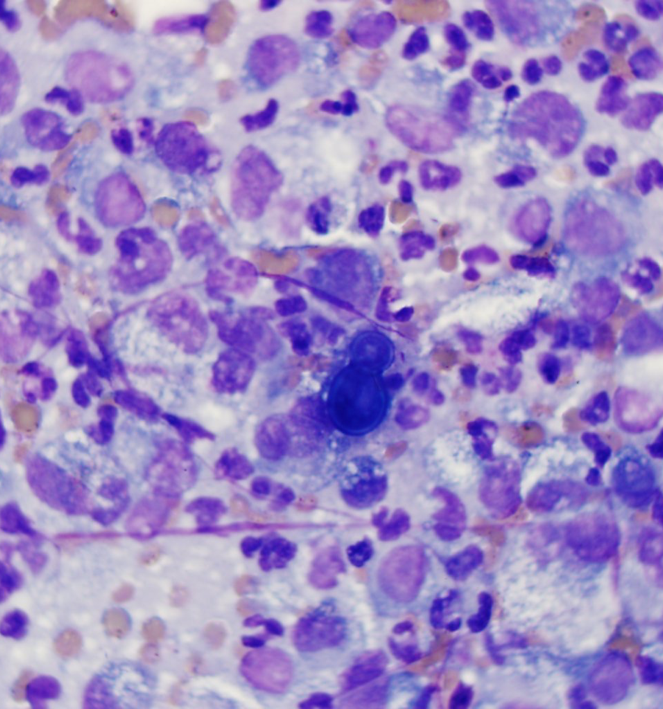
Fungi are ubiquitous. Most of them are harmless but a few are pathogens. One of them is Blastomyces dermatitidis. It can be commonly found in soil or decaying wood, in the damp places where sunlight cannot reach easily. Dogs are likely to develop this disease if they visit an area that has a huge number of Blastomyces dermatitidis. If inhaled, it reproduces inside the host’s body and spread throughout the body.
This fungus has a high prevalence in different parts of the United States of America, especially in Mississippi, Ohio, Missouri, and Tennessee River basins. Cats also suffer from this disease in the same way as dogs do. Dogs are much more susceptible to this disease in comparison to the other species. A human can also become infected by this disease but dogs are 10 times more likely to catch and develop blastomycosis.
Blastomycosis in dogs [cytology]:
Contents
Cytology and histopathology help in the diagnosis of blastomycosis. The fluid that is draining from the open wound and then tested by the vet. This diagnostic test confirms the presence of blastomycosis in the dog. There are certain screening tests for further confirmation like AGID.
Symptoms:
The incubation period is 5 to 12 weeks. Blastomycosis in dogs symptoms are:
- Eye inflammation and eye discharge
- Difficulty in breathing
- Wheezing and coughing
- Pus filled skin lesions
- Fever
- Anorexia (loss of appetite)
- Weight loss
- Limping and laziness
Lungs and eyes during blastomycosis:
The most common organs that get affected by the fungus are the eyes and lungs. These two organs show most of the symptoms like coughing, producing unusual sounds, inflammation in eyes, and discharge from eyes. Pulmonary areas are infected in 85% of the dogs suffering from blastomycosis. Moreover, the signs of ocular blastomycosis were noticed in 40% of the dogs that led to retinal detachment, glaucoma, and blindness. Apart from these two, blastomycosis affects the brain, bones, skin, and lymph nodes.
Causes:
This disease will occur in dogs when they get vulnerable to the air which is filled with fungi spores. Moreover, it can get along with the dog, if the dog is playing in the dirty soil. The spores of Blastomyces dermatitidis can enter the body of your dog through the nose during inhalation as well as penetrating through the skin. Exposure to areas that are moist, filled with decaying matter, and recently excavated areas are more prone to produce blastomycosis in your dog.
Blastomycosis is more common in male dogs and larger breeds of dogs (more than 25 kg).
Diagnosis:
As soon as a dog exhibits the signs and symptoms of blastomycosis, rush with your dog to a vet. Timely diagnosis increases the chances of a better and quick recovery. The best and most effective way to diagnose blastomycosis is to collect and test the fluid being drained from the lymph nodes. Moreover, collecting samples from trachea and lung tissues can also help. The complete process of the diagnosis involves a physical examination of the body of the dog, blood tests, urinalysis, etc.
Prevention:
There is no specific formula or way to keep your dog safe from blastomycosis. Try to you’re your dog away from the affected areas or the areas where there is a possibility of the presence of Blastomyces dermatitidis. Blastomycosis does not spread from dog to dog or dog to human. This disease is not contagious.
Prognosis:
Blastomycosis is a fatal disease if not diagnosed or left untreated. The prognosis of the disease is good and nothing to worry about if the pet owner can afford the treatment for quite a long time. The mortality rate in dogs suffering from blastomycosis is 14%. Dogs often die from this disease when the brain is involved. The prognosis of retention of vision is variable depending upon the immunity and previous eye problems of the dog. The prognosis of the dog is worse if the brain or eye is affected.
Treatment:
Here is a list of antifungal medicines which are given to the dogs when they suffer from blastomycosis:
- Itraconazole
- Ketoconazole
- Fluconazole
- Amphotericin B
In addition to the medicines, there are some therapies too. The medications for blastomycosis are usually long-term and treatment can be continued at home if the disease is not severe. The severely affected dogs may need intravenous fluids, pain killers, and cleaning of skin lesions. If the lungs are severely affected, the treatment can be painful in the beginning because mass deaths of Blastomyces dermatitidis lungs can cause respiratory issues, etc.
If the eyes are severely affected, medication cannot be much affected because medicines cannot penetrate and deal with the eye issue and in such cases, surgery becomes inevitable. If the eye of the dog is severely affected, enucleation (removal of the eyeball) is the last option of treatment. This disease does not go away easily. Keep a close check on the dog on a daily, weekly, and monthly basis.
Can humans catch this disease from their infected pets?
No, this fungus does not spread from one body to another. It does not mean that pet owners should not be precautious anymore. Strict hygiene should be followed while taking care of your infected dog such as doing things like handling the draining skin lesions of your dog. Wear gloves while touching the dog and wash the hands thoroughly after dealing with the infected pet. No need to isolate the pet from the family, unless you have any of the following as your family member because then the dog should be in a restricted space.
- Infants
- Chemotherapy patients
- Organ transplant patients
- Elderly family members
- Anyone having immune system disease
Basically, keep all people with low immunity away from the infected pet.
Conclusion:
Go on walks with your lovely dog but avoid going to the moist places if you want the good health of your dog. If your dog falls prey to blastomycosis, it will be a painful situation, not only for you but also for your dog that will be bearing the pain physically. If you find any symptoms of blastomycosis in your dog, rush to the vet because the timely diagnosis can save you and your dog from further troubles.